-
Posts
7,746 -
Joined
-
Last visited
Content Type
Profiles
Forums
Articles
Posts posted by kye
-
-
-
8 hours ago, kidzrevil said:
I am interested in this as well ! How would you set up your sequence and export it ?
I do everything in Resolve.
I imported the footage into Resolve onto a 1080x1920 timeline, and then the first thing required is to rotate it so it's the right way up. I'm not sure if the camera doesn't support orientation sensing in video or if Resolve doesn't support it or if I tilted the camera the wrong way, but it's a simple fix.
Editing and colouring were as you would expect, just with a vertical image. One amusing thing is that the thumbnails shown in the nodes in the Colour page are tipped on their side

The export process was as normal too. I haven't uploaded a vertical video yet so that part I can't speak to. I expect that the codec bitrate and compression challenges are all the same as for normal aspect ratios, but in a sense they're less important if you're aiming at smartphones because the phone is less revealing as a display device and the nature of these videos is different.
In terms of it being different, I didn't see any difficulties, or at least not yet!

-
43 minutes ago, JBraddock said:
Apparently, square videos generate more engagements according to this experiment.
Interesting article - thanks.
Pity they didn't include vertical video too!
-
On 20/02/2018 at 10:49 PM, UncleBobsPhotography said:
The advantage with vertical shooting is that people's expectations are much lower and it's much easier to stand out among other vertical videos. I have shot some vertical videos (with a proper camera) for facebook, and I would definitely recommend it for short facebook content.
I suspect you're right about expectations, and even straight-out of camera it sure looks pretty nice when you look at it on the phone.
18 hours ago, IronFilm said:Also shot this on the side, so as to squeeze a little more resolution from the BMPCC for VFX:
Cool - that's lateral thinking at its best!
7 hours ago, Matthew Hartman said:I would be careful shooting vertical merely to fit a social media platform.
It's not about a social media platform, more that people don't rotate their phones unless the content is deliberately cinematic (eg, Netflix). In terms of longevity, these are PR videos that are designed to be part of a larger narrative, and thus have a very short shelf-life.
I've heard some of the leaders in social media marketing saying that telling your personal story on social media about how you're trying to build your business (or whatever project) is on average likely to be worth more because of the social following you're likely to attract is worth a certain amount, whereas the average business fails miserably.
I've also heard that some large proportion of videos on social media are consumed without sound(!) presumably because the person can't untangle their headphones from the ball of cable that their pocket or handbag turns them into.
It's a brave new world - social media creators are shooting basically disposable content on real budgets, sometimes RED cameras, with pro sound, lighting, the works!
-
Considering it's a new-camera internet tradition and no-one else has said it, I'll go first...
I wouldn't buy this camera unless it has:
- 4k 60p from the whole sensor with no pixel binning
- IBIS
- C-Log
- 422 400Mbit/s intraframe codec...nope, I just can't keep typing!

- RAW!!
..ok, I'll stop now!

-
Surely if we were to attempt a grade, it would be helpful to know what kind of movie it is? Rom-com vs psychological thriller might attract a different look surely!

-
I shot my first proper vertical video on the weekend - getting setup to film PR videos for my fiancé's new business in the social services sector.
The videos are targeted for FB and my fiancé informs me that people don't tilt their phones for these type of videos, so vertical is the way to go.
The setup we got to after about 5 iterations was Canon 700D tilted 90 degrees so the flip-out screen was above the camera where the talent could see it, tungsten key light, practical fill from ceiling light and white bounce, and two small LED kicker / hair lights positioned off to the sides and slightly behind the talent.
When you white balance to the tungsten the LEDs go a bit blue creating some colour contrast and the colours straight out of the Canon are very pleasant. 9:16 looks very tall and narrow and looks very strange in Resolve, but fills the screen of the iPhone, so I'm informed that it's the right aspect ratio.
I'm still yet to work out how to make lower third titles look half-decent though.
Anyone else shooting vertically?
[Edit: forgot to mention the Canon 50mm f1.8 lens, which on APSC is 80mm equiv. I had it set to f1.8, but after seeing how much the codec obscures detail I might back it off to make focusing easier]
-
15 hours ago, Matthew Hartman said:
Unfortunately Samsung is hell bent on increasing the prices for their flagship year over year. The S9/+ is rumored to have a price tag of $820-$960.
Still below the iPhone X 256Gb!
There's a principle I've heard of where you apply the 80/20 rule to product pricing, and it basically says that if you have X customers willing to pay $Y for something, then X/10 of them will be willing to pay $(Y x 10) for something else that's better. I've been continually surprised that billionaires buy the same phones that the Apple store employees can afford because no-one has designed something way more expensive for them.
-
I started with stills, after I discovered that my memories of holidays gradually conformed to the photographs I took and the rest of it is mostly forgotten.
Shooting stills on holiday pushed me through multiple cameras into DSLRs and into street photography (the best analog for holiday shooting I've found) in order to practice and improve in-between holidays. Through multiple holidays I got into editing (shot selection), processing (Lightroom, photoshop) and retouching.
I then started taking video but realised I didn't know what to do with it (and neither did anyone else - someone showing you that 'funny moment' from their trip is normally you watching them look for it for 30 minutes through all the clips they shot) so I decided to teach myself video editing. This lead onto colour correction and grading.
I then realised that when you're recording video you're missing out on stills, and vice versa. I also realised that 2MP is enough for printing 5x7s and 5MP is enough for 8x10s (assuming they're for family and friends), that 1080 is 2MP and 4K is 8MP, and that video is continuous burst mode, and that pulling a still from a video would enable you to choose the perfect moment 'peak smile'. This pushed me into professional video cameras (for the high bitrate, and high dynamic range) and of course I chose a 4K camera.
I'm still stuck in video and haven't come up for air yet to try and pull still images from the footage I'm recording, but I'm editing and grading and all that good stuff.
You can't hang a video on the wall (yet) and you can't see how people move and act and laugh in photographs. They're just different.
-
On 15/02/2018 at 1:14 PM, IronFilm said:
Heck, even with their current high prices, here is this High Schooler who purchased a Scarlet-W (although yes, we can't call him an amateur, as he worked hard for it!):
Seeing him talking about the RED while running B-roll of the a6000 made me think "Wow - those cameras aren't as large as I thought..... oh, wait a minute!"

In terms of RED getting into the high-end smartphone game, that's an interesting concept.
Apple has been trying to strangle the market by keeping their entry-level offerings about the same price while simultaneously adding products at the top end:

I haven't heard of many examples of smartphones coming in above Apples flagship phone, but if someone was going to do it, having a RED branded camera in it would sure be a decent strategy.
-
2 hours ago, markr041 said:
Its here: Sony FS5, Sony FS7 have as an option built in auto variable electronic ND continuous smooth. Does exactly what you want - set shutter, aperture, ISO, and exposure is set automatically. Choose your DOF and not worry about lighting conditions. Great for run and gun, doc, eng. No need for clickless aperture lenses.
Excellent - thanks for letting me know. In my case it's not the fact it's in the FS5 and FS7 which are both too large and expensive for me, but that it's been done and there's hope for trickle-down.
1 hour ago, IronFilm said:Note that some people feel variable NDs tend to harm the image more than high quality NDs would.
I think I recall watching an interview at an expo after the FS5 came out, with an engineer explaining how it wasn't an easy feat and the struggles they had.I suspected this. I once bought a cheap variable ND from eBay and when I got it it worked well at minor attenuation, but when you started to really make it dark it got these strange banding interference patterns, which I suspected were due to imperfections in the alignment of the two coatings. To get this to a level that is below what a 4k 16bit RAW (or higher) sensor can resolve would be no mean feat, so I was anticipating that the tech would likely be done some other way (LCD perhaps) but that it would be difficult to get up to quality standards.
Thanks guys, that answers my question

-
For me the important thing isn't that lots of people make films on tight budgets, it's that people CAN make films on tight budgets. The more accessible it is for people to get their feet wet the less of the talented people will 'bounce off' the industry and we'll never see what they might have created.
-
Interesting @DBounce I hadn't seen that. If there are patents involved then maybe that's the reason.

None of these are AUTO electronic variable ND.. maybe I should have put that in the thread title.
We have AUTO shutter speed (in aperture priority or P-mode), we have AUTO aperture (in shutter priority or P-mode), we have AUTO ISO..... why no AUTO ND?
I can understand why camera don't have a dual ISO, I would imagine that costs more to implement, but cameras already have built-in NDs, so why Canon doesn't just buy Aputure and install them (or license the tech) doesn't make sense. In terms of manufacturing, both solutions require optical-quality tinted glass, room between the lens and the sensor, a motor, and some kind of control mechanism, and being able to say "Built-in auto variable ND" even seems like better marketing than "Built-In ND Filters with Manual Controls".
I'm guessing that eventually we'll have a camera that uses AI to recognise skin tones in various lighting situations using a combination of face detect and clever keying, will do some analysis on the dynamic range of those skin tones, and will then adjust exposure to keep the normalised mean skin tone exposure at a set exposure level (and if you're lucky it will be user-specified in IRE), but why we have to wait for Artificial Intelligence to get AUTO ND seems completely stupid to me.
I want a camera that I can set to 1/50, f2.8 and auto exposure and then go point it at people running around in full sun, point it at the sun during sunset, point it at people watching the sunset with golden hour exploding all over their faces, and then point it at people sitting around having wine and talking through blue hour and into night with practicals and candlelight, AND HAVE THE CAMERA DO AUTO EXPOSURE THAT WHOLE TIME. This is what I need for my home videos of friends and family etc, but I'm sure that the run-and-gun doc filmmakers working in sketchy situations in the jungle, or war-torn cities would also appreciate one less thing they need to worry about.
The less time I'm thinking about exposure, the more time I'm thinking about composition, camera angle, zoom vs distance to subject, the psychology of directing people (and trying not to make people uncomfortable), shot selection and how it will end up being used in the edit, and balancing the need to get good footage vs being on time for dinner.
In summary, GRRRR.
-
Most cameras can be set to 1/50th shutter, a desirable aperture, and automatic ISO, which means that if the scene gets a little darker the camera compensates. This is what machines are for.
Why haven't we got the same thing when we are at base ISO and it gets a little brighter? Even if purely electronic variable NDs aren't up to optical standards, why isn't there a high quality variable ND in there with a little motor to wind it back and forwards?
Shutter speed and aperture are artistic controls and should be in the hands of the operator, ISO and ND filters are not creative, therefore they should be automated.
It doesn't seem like an insurmountable technical problem to me - what's the deal?
(or if it is, why don't we have dual-ISO cameras where the second ISO is something like 5?)
-
2 hours ago, mercer said:
Thanks but no. I had the camera last year. I really liked the camera, though but eventually moved onto the 5D3 and Raw Video.
How do you like it? I’m hoping the rumor that the XC20 will have an interchangeable lens mount is true.
I'm still making friends with it, working out settings and getting it setup with ND filters etc, and have only really shot one project with it, but it seems relatively intuitive for my run-and-gun style of shooting.
In terms of an XC20, there are only a few things about the XC10 that make me think about other cameras, and I'm not sure how likely it is that an XC20 would fix them.
I'd really like more accurate focus peaking (it's very optimistic about what it in focus), some higher bitrate options for the 1080 modes, and maybe a second ND filter, but that's all I've bumped into so far on it.
In terms of the grass being greener, yeah, an F1.0 lens would be great, but would I sacrifice zoom range to get it, probably not - being able to point the camera at whatever is going on and not having to change lenses all the time sure is liberating. Besides, if you were going to have to swap lenses to get shallow DOF then the logical choice would be the Sigma f1.8 zoom lenses, which don't have image stabilisation, so for me the XC20 would either have to have IBIS or I'd have to put it on a gimbal, which is yet another thing that is heavy, can break, requires batteries / chargers / charging / etc.
And of course, higher frame rates, RAW, makes coffee, etc.. I think it's probably good enough for me to wait for the GH7 or something like that! -
On 08/07/2016 at 11:27 PM, mercer said:
Does anyone have any ungraded C-Log from the XC10... 1080p and 4K?
Still interested in this? If so, what settings and style of shot do you want?
-
Two points:
1) any additional competition in the market is good for us.
2) 8K capture doesn't mean 8K playback. For a given bitrate you're better off with the higher resolution file, and even if it's larger HDDs are getting cheaper all the time.
I'm waiting for a decent high bitrate 4K 360degree camera so that I can record everything without having to choose where I'm pointing the camera in the field - you can choose that in post, including as many camera angles, face tracking, stabilisation, or whatever other post-processing you like. I see vloggers shooting 360 and cropping in in post occasionally, but the problem is that they're cropping in to a poor quality file, but that will change.
Film and lower quality digital has groomed the entire industry into thinking that you must use all of the frame that you shoot, consumers don't think like this, and this is the market that we're talking about here.
If you think I'm crazy or that it won't happen, go refresh your knowledge of Moore's Law

-
-
In terms of GAS, I'd suggest making a list of what you need to shoot your videos, and what problems you have with your current setup.
Then look at the potential purchase and see if it fixes any of your problems while still meeting your other criteria.
Then think about if the size of the problem is large enough to justify the cost of buying the new equipment.
If the purchase passes those tests (and you can afford it), then buy it. If it fails, it's GAS.
Good luck!

-
I cut out a section of a grey paint sampler from a hardware store and stuck it on the inside of my lens cap for this purpose. I'm yet to use it so can't speak for how effective it is.
I've previously verified that it's close to a neutral shade of grey by getting the whitest paint sampler I could (I grabbed a few and then using fixed exposure looked at which had the highest RGB values), I white balanced on that white paint sampler, then looked at the RGB values of a bunch of grey paint samplers and chose the 'shade' with the least colour in it.
For my style of shooting it should get me close enough.. just an idea about how to do it on a severe budget

-
I've done further analysis and figured I would round the conversation out by sharing it.
Here's some shots from the ARRI reel.
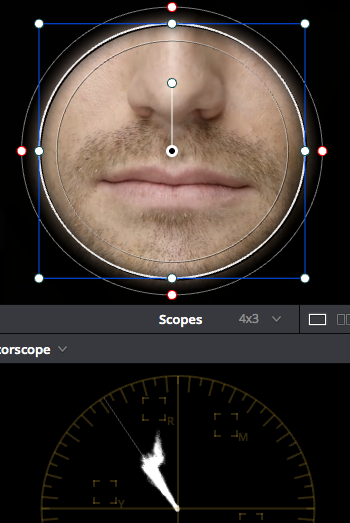
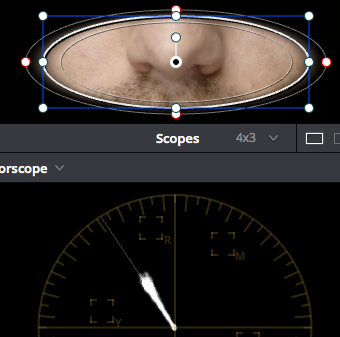
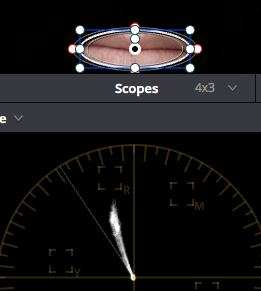
His skin is very uniform in hue basically centred on the line in the vector scope, with the exception of his lips, which appear in the overall pic as being of a very limited saturation, but when isolated seem to show more range. Note that the skin tones are evenly distributed in saturation up to a certain point, beyond which they don't seem to go, however the red in the lips goes further into saturation than the skin tones.
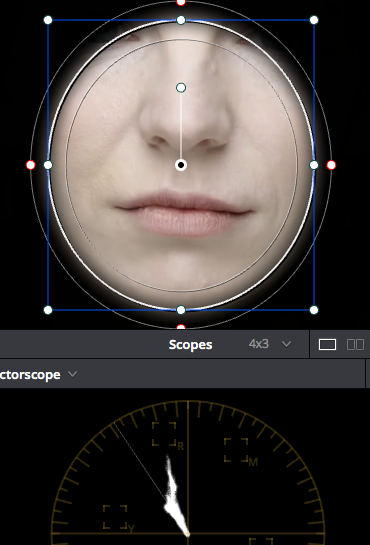
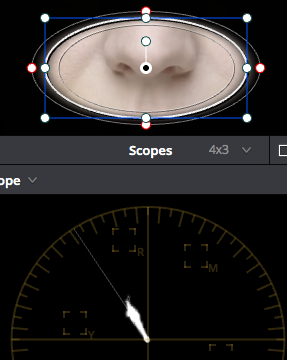
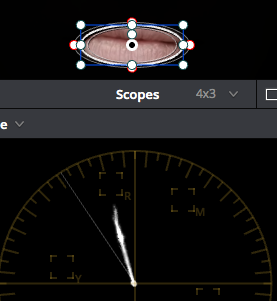
It's the same story for this lady, except that her skin tone has the majority of it on the pink side of the indicator line, and her lip colour is almost pointing directly at the Red calibration box.
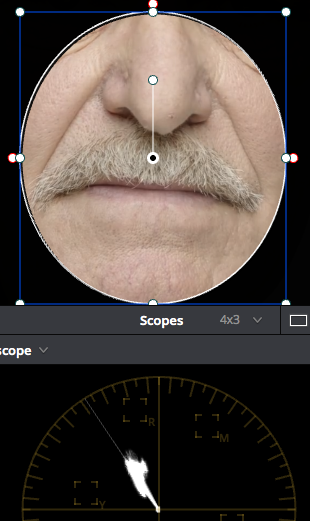
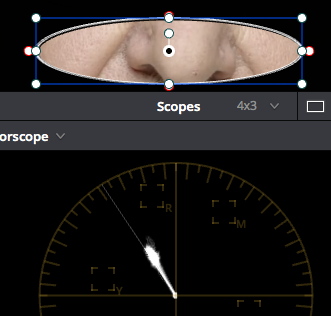
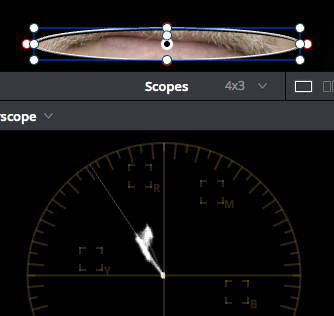
It's the same story for this gentleman, even including the hair in his moustache, with the exception that his lip colour isn't more saturated than his skin colour.
Now, if we turn to Canon and their demo reel From Dock to Dish, which I thought was a reasonable comparison considering that it was the promo for the C200 camera, we get these graphs.
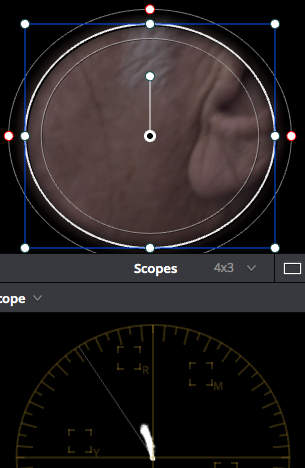
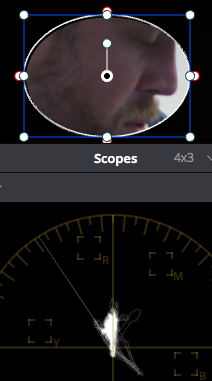
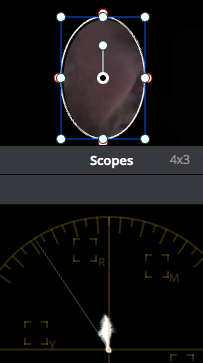
These two fishermen both have skin-tones that are not only all on the red side of the indicator line, but there's even a healthy gap. It does look cold conditions so it makes sense they're a little flushed.
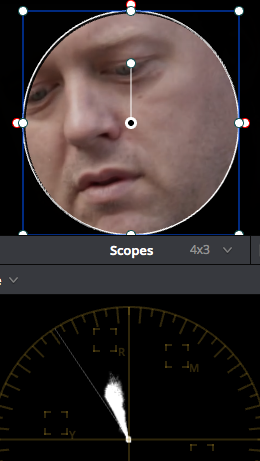
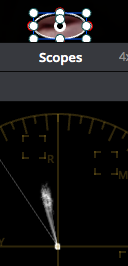
This guy also has tiny gap between his skin-tones and the indicator line, and his lips were pointing at the Red calibration box.
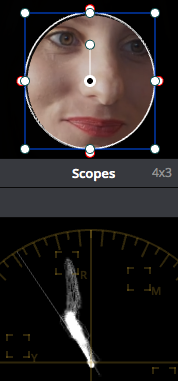
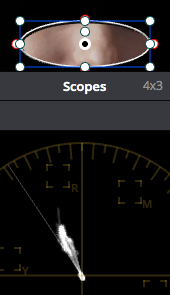
This lady is also all on the red side of the indicator line.
So, it appears that ARRI tends to place their skin-tones either next to the line with some of the information on the yellow-side of the indicator line, or they go as far as centring the skin colours on that line (as in the case of the top example), and they're not afraid of going over the line assuming it's balanced (as in the case of the lady in the second example).
Canon, however, placed the skin-tones so that all the information is to the red side of the indicator line, even including a small gap in examples where the hue distribution was less.So, ARRI are around and over the line, Canon are next to and perhaps a little distance from the line.
In terms of hue variation, both ARRI and Canon show examples of a moderate a amount of hue variation, but ARRI also has examples of lower amounts of hue variation, and Canon showed examples of a greater range of hue variation than ARRI did. Both aimed their lip colour either at, or nearly at, the Red calibration box.
-
I give up.
This thread started with two very long and nuanced articles about colour reproduction in demo reels. It's transitioned to a conversation that can be summed up by me saying "the ARRI skin tones all appear to be on the yellow-side of the acceptable range of skin tones" which you summarised as me saying "calling the Arri shots yellow" and they looked "off".
Bonus points for managing to infer I'd never heard of a colourist, or insulting me based on the camera I own. Best of luck in your future endeavours - if you're like this to everyone new that you meet, you're going to need it.
-
The ARRI footage is lovely, the demo is hugely impressive, and if someone was to offer me a free camera I would fly anywhere in the world to come collect it. But I think you guys are missing my point, I'm trying to understand where within the realm of acceptable skin-tones it sits.
If we start with the concept that the C200 clips show skin tones that are redder than the reddest person in the ARRI footage, then one of the following statements must be true:
1) If the C200 colours are acceptable as skin tones, that would mean that the range of acceptable skin tones contains skin as yellow as the ARRI footage and as red as the C200 clips, which means that the ARRI skin tones are all on the yellow side of the acceptable skin tone range.
or
2) The ARRI footage is not at the yellow side of the acceptable skin tone range, but is more neutrally presented, which means that as the C200 skin tones are considerably redder then this they must be unacceptably red and outside the realm of acceptable skin tones.
I believe it's the first one, and that it's just a style thing, or an ARRI 'look'. The C200 footage thread contained positive feedback about some of the grades from the films I screen-grabbed, so I'm guessing they're within the acceptable range of skin tones.
Please note that at no point did I mention anything subjective in the above statements, it's quite simple - either Canon is fine and the ARRI is yellow-biased or the ARRI isn't yellow-biased and the Canon grades are out of bounds. I'm just trying to understand which is which. Maybe it's too obvious a question and you guys are reading into it some kind of subtext?
-
Hi Jonpais.
I think you misunderstand me. I am saying that the ARRI skin tones all appear to be on the yellow-side of the acceptable range of skin tones, not that they're out of the acceptable range. As someone who has quite a lot of colour variation in my own skin tones (a model I am definitely not!) and I lack willing volunteers for my camera tests I end up grading myself - both in still images and video - so I'm familiar with the problem of people who are pink in some locations (lips, around the nose, in the ears, etc) and yellow in others (temple areas, shadows under the chin, etc).
I shoot Canon which I know has a red tinted bias but I thought was still acceptable, especially if you compress the skin hues with the Hue vs Hue curve in Resolve.
The reason I didn't mention what I am viewing these on (MacBook Pro 2016 calibrated with Datacolor Spyder 4 PRO in my studio with all controlled lighting) is that I am an amateur and new to the colour game and my monitor is far more calibrated than my eyes. That being said, while I wouldn't trust my own grading, I do trust the professionally released C200 videos I linked above. The C200 videos showed a range of skin tones, some on the yellow side similar to ARRI and some on the redder side which I chose for the screen captures above. All of the screen grabs I took are pinker than the pinkest person in the ARRI video.
The gentleman on the left with the tie from the ARRI video has quite a lot of hue variation in his skin - typical of an older person, however the hue differences *as shown in the ARRI video* are pretty minimal - look at the colour of all of their lips for example. I would suggest the model probably has pinker skin tones than all of the people from the C200 videos (with the possible exception of the guy in the cap who has a touch of sunburn on his nose) yet the ARRI video doesn't show this - it shows barely any variation in hue.
My original question was a genuine question and not a veiled criticism, and it still stands - is this preference for yellow skin tones (which are on the yellow side but still quite acceptable) an ARRI 'look'? In the way that Canon prefers redder ones? Or is this part of the grade?
The author of the two articles in the original post of this thread talked at length about camera manufacturers making choices that determined their looks, both from an aesthetic perspective and also from a technical perspective to work around the limitations of their hardware, so this is the context of my question.






How stills killed casual video for me
In: Cameras
Posted
In a sense, going from one medium into another is taking another step forward into seeing the beauty in everything.
I remember years ago when I was working on a music project with a friend and we were writing abstract minimal electronic music, we got to the point where everything had artistic value. We were auditioning a song and quite by chance one of my neighbours unlocked their car, and the beep from that coincided spectacularly with the track. Everything is about context, and so if you can change your brain to be open in the right ways then everything is art.
Moving from one medium into another is learning to see and appreciate things we hadn't before.